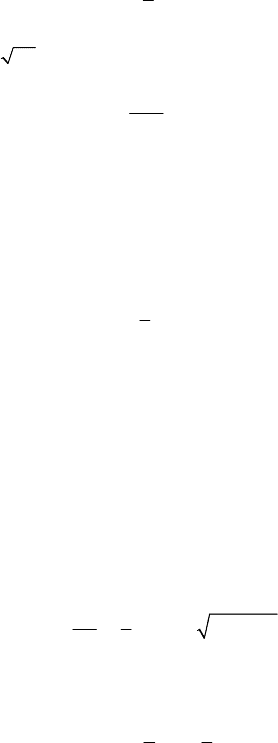Teodorescu P.P. Mechanical Systems, Classical Models Volume I: Particle Mechanics
Подождите немного. Документ загружается.


MECHANICAL SYSTEMS, CLASSICAL MODELS
734
Let
()xϕ be a basic complex function of a real variable x ; hence, ()xCϕ
∞
∈ and
has a compact support (e.g.,
xa
≤
). By the formula (A.3.8), the Fourier transform of
the basic function is
[]
i
F() () ()ed
ux
xu xxϕψ ϕ
∞
−∞
==
∫
. (A.3.10)
The function
()uψ may be defined also for complex values isu v
=
+ , namely
ii
() ( )e d ( )e e d
sx vx ux
sxxxxψϕ ϕ
∞∞
−
−∞ −∞
==
∫∫
. (A.3.10')
The set of functions
[
]
() F ()sxψϕ
=
, where the support of the basic functions is
included in the segment
[
]
,aa− , forms the vector space ()Za . We denote by
()
a
ZZa
=
∪ , ()
a
KKa
=
∪ (A.3.11)
the new complex linear space; then,
Z
′
is the set of linear and continuous functionals
defined on
Z (ultradistributions).
If
F( )s is a distribution defined on Z and ()
f
x is a distribution defined on K ,
then the functional
F( )sZ
′
∈ , specified by the equality of the Parseval type
(F( ), ( )) 2 ( ( ), ( ))ss fxxψπϕ
=
, (A.3.12)
is called the Fourier transform of the distribution
()
f
x and is denoted by
[
]
F( ) F ( )sfx
=
. (A.3.13)
We can also write
[
]
[
]
(
)
F(),F() 2((),())
f
xx fxxϕπϕ
=
. (A.3.12')
Analogously, one may introduce the Fourier transform of a distribution of several
variables.
The classical properties of the Fourier transform are maintained in the form:
i)
(
)
(
)
[][ ]
dd
F() F () F (i)()
dd
PsP fxPxfx
ss
==
, P polynomial;
ii)
(
)
[]
d
F()(i)F()(i)F()
d
PfxPsfxPss
x
⎡⎤
=− =−
⎢⎥
⎣⎦
;
iii)
[
]
[
]
1
F F () ()
f
xfx
−
= ;
iv)
[
]
[
]
FF () 2 ( )
f
xfxπ=−.
We denote by
1
F
−
the inverse operator defined on Z
′
.
We can prove the relation

Appendix
735
[
]
[
]
[
]
F() () F() F()
f
xgy fx gy
×
=× (A.3.14)
for the direct product of two distributions. As well, in connection with the convolution
product, one may show the relations
[
]
[
]
[
]
F() () F()F()
f
xgx fx gx
∗
= , (A.3.15)
[
]
[
]
[
]
F()() F() F()
f
xgx fx gx
=
∗ . (A.3.15')
The first relation is valid if
()
f
xS
′
∈
and ()gx is a distribution with bounded
support; the second relation is valid if
()
f
xS
′
∈
and the function ()gx C
∞
∈ is such
that
()()
f
xgx S
′
∈ and the support of its Fourier transform is bounded.
We mention the Fourier transforms:
[
]
F() 1xδ
=
, (A.3.16)
[
]
12
F ( , ,..., ) 1
n
xx xδ
=
, (A.3.16')
[
]
i
F( ) e
ua
xaδ −=
, (A.3.16'')
[]
i
F() ()xu
u
θπδ
=
+ , (A.3.17)
[]
2
1
Fi()xu
u
πδ
+
′
=− − , (A.3.17')
[
]
F1( ) 2 ( )xuπδ
=
. (A.3.17'')
3.2.2 Laplace transform of a distribution
Let
()
f
x be a complex function of a real variable, which satisfies the conditions:
i) () 0
f
x = for 0x < ;
ii)
()
f
x is piecewise differentiable;
iii)
() e
ax
f
xM≤ , where M is a positive constant, while the non-negative constant
a represents the incremental ratio of the function.
Then the function
L( )p of the complex variable ipu v
=
+ , defined by the expression
0
L( ) ( )e d
px
pfxx
∞
−
=
∫
(A.3.18)
is called the Laplace transform of the function
()
f
x and is denoted by
[
]
L() L()
f
xp
=
. (A.3.18')
The function
()
f
x is also called the original function and the function L( )p the image
function. To the Laplace transform thus defined there corresponds an inverse Laplace
transform, given by

MECHANICAL SYSTEMS, CLASSICAL MODELS
736
[]
i
1
i
1
LL() () L()ed
2i
u
px
u
pfx p p
π
+∞
−
−∞
==
∫
, ua> . (A.3.19)
If
()
f
x is a distribution having its support on the half-line
0x ≥
and is such that
the distribution
()e
px
f
x
−
is a temperate distribution, then
[
]
(
)
L() (),e
px
f
xfx
−
=
(A.3.20)
represents the Laplace transform of that distribution. It is obvious that the relation
(A.3.20) generalizes the relation (A.3.18).
We mention the properties:
i)
[
]
[
]
L( ) e L()
pa
f
xa fx
−
−= (the delay theorem);
ii)
[]
(
)
1
L() L
p
fkx
kk
=
, 0k > (the theorem of similitude);
iii)
[
]
L()e L( )
qx
f
xpq=− (the theorem of translation; the damping theorem).
One may give analogous results for the distributions of several variables.
In the case of a derivative of a distribution one may write
[
]
[
]
L() L()
f
xpfx
′
=
. (A.3.21)
For a convolution product it results
[
]
[
]
[
]
L() () L()L()
f
xgx fx gx
∗
= . (A.3.22)
We may write the Laplace transforms:
[
]
L() 1xδ
=
, (A.3.23)
[
]
12
L ( , ,..., ) 1
n
xx xδ
=
, (A.3.23')
()
L()
mm
xpδ
⎡⎤
=
⎣⎦
, 0,1, 2,...m
=
. (A.3.23'')
3.3 Applications to the study of differential equations. Basic solutions
The theory of distributions is particularly useful in the study of ordinary or partial
differential equations, as well as in the case of various boundary value problems. We
shall give first some general results concerning the basic solutions and then we shall
deal with the problem of obtaining them for some particular differential equations.
3.3.1 Ordinary differential equations
Let be the linear ordinary differential equation with constant coefficients
() ( 1)
1
D() () () ... () ()
nn
n
yx y x ay x ayx fx
−
≡+ ++=, (A.3.24)
where
()
f
x is a distribution. The distribution ()Ex which satisfies the equation

Appendix
737
D() ()Ex xδ
=
(A.3.25)
is called the basic solution of the equation (A.3.24) and is of the form
() () ()Ex Yx E x
+
=
+ , (A.3.26)
where
()Yx is the general solution of the homogeneous equation
D() 0Yx
=
, (A.3.27)
while
()Ex
+
is a particular basic solution (corresponding to the non-homogeneous
equation (A.3.25)). We shall give a simple method for determining this solution; to this
end, we determine first the solution
()Yx which satisfies the initial conditions
(2)
(0) (0) (0) ... (0) 0
n
YY Y Y
−
′′′
==== =
,
(1)
(0) 1
n
Y
−
=
; (A.3.28)
one can prove that a basic particular solution is, in this case, given by
() ()()Ex Yx xθ
+
=
. (A.3.28')
The basic solution of a differential equation is useful to determine its general
solution; thus, the general solution of the equation (A.3.24) is given by
() () ()yx Ex f x
=
∗ . (A.3.29)
Let now be again the equation (A.3.24) with
0x > , ()
f
x being a continuous
function having the support in
[0, )
∞
; in the case of initial conditions of Cauchy type
()
(0)
k
k
yy= ,
0,1,2,..., 1kn
=
−
, (A.3.30)
the solution of the equation (A.3.24) is expressed in the form
1
0
d
() () ()() ()
d
k
n
k
k
k
yx Ex fx x h Ex
x
θ
−
++
=
=∗ +
∑
, (A.3.30')
where the coefficients
k
h , 0,1,2,..., 1kn
=
− , are given by
0
1
12 1
...
knk nk nk
hy ay a y
−− −− −−
=+ ++ . (A.3.30'')
The solution of the homogeneous equation
D() 0yx
=
(A.3.31)
for
0x ≥ , with the initial conditions of Cauchy type (A.3.30), is given by

MECHANICAL SYSTEMS, CLASSICAL MODELS
738
1
0
d
() ()
d
k
n
k
k
k
yx h E x
x
−
+
=
=
∑
. (A.3.31')
In particular, in the case of the differential equation
()
() ()
n
yx fx= , (A.3.32)
with initial conditions of the form (A.3.30), we obtain the basic particular solution
1
1
1
() ()
(1)!(1)!
n
n
x
Ex x x
nn
θ
−
−
++
==
−−
, x
∈
\ ; (A.3.33)
the solution of the boundary value problem is given by
21
1
0
12 1
0
1
( ) ... ( ) ( )d
2! (1)!(1)!
n
x
n
n
xx
yx y yx y y x f
nn
ξξξ
−
−
−
=+ + ++ + −
−−
∫
,
(A.3.32')
where the latter integral, which represents the convolution product, is known as the
Cauchy formula; for
2n =
, we get
()Ex x
+
+
=
. (A.3.33')
The above ideas may be extended to systems of ordinary differential equations with
constant coefficients.
3.3.2 General considerations on partial differential equations
Problems similar to those in the preceding subsection may be put in the case of
partial differential equations. Let thus be
12
12
, ,..., ; ( , ,..., ; ) 0
m
m
Puxxxt
xx x t
∂∂ ∂∂
⎛⎞
=
⎜⎟
∂∂ ∂ ∂
⎝⎠
(A.3.34)
a homogeneous linear partial differential equation of nth order with respect to the
variable
t , with constant coefficients. For example, the Cauchy problem for this
equation consists in the determination of the function
12
( , ,..., ; )
m
ux x x t which
satisfies the equation (A.3.34) and the initial conditions
00
12 12
( , ,..., ; ) ( , ,..., )
mm
ux x x t u x x x
=
,
0
12 112
( , ,..., ; ) ( , ,..., )
mm
ux x x t u x x x
t
∂
=
∂
,
. . . . . . . . . . . . . . . . . . . . . . . . . . . . . . . . . . . . . .
1
0
12 112
1
( , ,..., ; ) ( , ,..., )
n
mm
n
n
ux x x t u x x x
t
−
−
−
∂
=
∂
.
(A.3.34')

Appendix
739
To solve this problem, we consider the function
0
12 12
( , ,..., ; ) ( , ,..., ; ) ( )
mm
ux x x t ux x x t t tθ
=
− , (A.3.35)
as well as the corresponding regular distribution; taking into account the formula which
links the derivative in the sense of the theory of distributions to its derivative in the
usual sense and using the initial conditions (A.3.34'), it results
00
12 12 12
( , ,..., ; ) ( , ,..., ; ) ( , ,..., ) ( )
mmm
ux x x t ux x x t u x x x t t
tt
δ
∂∂
=+−
∂∂
,
2
2
0
12 12 112
22
( , ,..., ; ) ( , ,..., ; ) ( , ,..., ) ( )
mmm
ux x x t ux x x t u x x x t t
tt
δ
∂∂
=+−
∂∂
00
12
( , ,..., ) ( )
m
uxx x t tδ+−
, (A.3.36)
. . . . . . . . . . . . . . . . . . . . . . . . . . . . . . . . . . . . . . . . . . . . . . . . . . . . . . . . . . . .
0
12 12 112
( , ,..., ; ) ( , ,..., ; ) ( , ,..., ) ( )
n
n
mmm
n
nn
uxxxt uxxxtuxxxtt
tt
δ
−
∂∂
=+−
∂∂
(1)
00 0
212 12
( , ,..., ) ( ) ... ( , ,..., ) ( )
n
mm
n
uxxxtt uxxx ttδδ
−
−
+−++ −
.
Noting that the derivatives in the usual sense with respect to the variable
t of the
function
12
(, ,..., ;)
m
ux x x t are equal to the corresponding derivatives of the function
12
(, ,..., ;)
m
ux x x t for
0
tt≥ , the equation (A.3.34) takes the form
12 12
12
, ,..., ; ( , ,..., ; ) ( , ,..., ; )
mm
m
Puxxxtfxxxt
xx x t
∂∂ ∂∂
⎛⎞
=
⎜⎟
∂∂ ∂ ∂
⎝⎠
(A.3.37)
in distributions, where
12
( , ,..., ; )
m
f
xx x t is a given distribution, which contains the
initial conditions considered above.
Thus, we call basic solution of the equation (A.3.37) the distribution
12
( , ,..., ; )
m
Ex x x t which satisfies the equation
12 12
12
, ,..., ; ( , ,..., ; ) ( , ,..., ; )
mm
m
P Exx x t xx x t
xx x t
δ
∂∂ ∂∂
⎛⎞
=
⎜⎟
∂∂ ∂ ∂
⎝⎠
. (A.3.38)
The solution of the above Cauchy problem is given by (A.3.35), where
12 12 12
( , ,..., ; ) ( , ,..., ; ) ( , ,..., ; )
mmm
ux x x t Ex x x t f x x x t
=
∗ , (A.3.37')
the convolution product corresponding to all
1m
+
variables.
It should be noted that some equations of mathematical physics cannot be always
deduced directly in the space of distribution, owing to the difficulties encountered in
modelling physical phenomena. In general, the equations which describe such
phenomena are obtained first by classical methods. Next, an extension is effected,
where the unknown functions take zero values, so that they be defined on the whole

MECHANICAL SYSTEMS, CLASSICAL MODELS
740
space; the derivatives, considered in the usual sense, are expressed by relations which
connect derivatives in the sense of the theory of distributions to the derivatives in the
usual sense of a distribution corresponding to an almost everywhere continuous
function, having a finite number of discontinuities of the first species. In this way, the
unknowns of the problem will be regular distributions; then it will be assumed that
these unknowns may be arbitrary distributions. Another possibility, which is frequently
used is to suppose, from the very beginning, that the unknowns of the problem are
arbitrary distributions, assuming the same form in distributions for the differential
equation obtained by classical methods (obviously, these ones are no longer valid for
the whole space). However, there are not general methods for passing to differential
equations in distributions.
3.3.3 Equations of elliptic type
Let be Poisson’s equation
123 123
(, , ) (, , )uxxx fxxxΔ
=
, (A.3.39)
where
123
(, , )
f
xxx is a given distribution; the basic solution is of the form
123
1
(, , )
4
Ex x x
rπ
=−
,
222
123
rxxx=++. (A.3.39')
Analogously, for the equation
123 123
(, , ) (,, )uxxx fxxxΔΔ
=
(A.3.40)
we have
123
1
(, , )
8
Ex x x r
π
=−
. (A.3.40')
In case of the equation
2
123 123 123
(, , ) (,, ) (,, )ux x x kux x x f x x xΔ += (A.3.41)
we may use the basic solution
123
1
(,, ) cos
4
Ex x x kr
rπ
=−
; (A.3.41')
we also notice that an integral of the homogeneous Helmholtz equation
2
123 123
(, , ) (,, ) 0ux x x kux x xΔ
+
= (A.3.42)
is given by

Appendix
741
123
1
(,, ) sinux x x kr
r
=
. (A.3.42')
Replacing
k
by
ik±
, i1=−, we find the basic solution
123
1
(,, ) cosh
4
Ex x x kr
rπ
=−
(A.3.43)
for the equation
2
123 123 123
(,,) (,,) (,,)ux x x kux x x f x x xΔ −=; (A.3.43')
analogously, we notice that
123
1
(,, ) sinhux x x kr
r
=
(A.3.44)
is an integral of the homogeneous equation
2
123 123
(, , ) (, , ) 0ux x x kux x xΔ
−
= . (A.3.44')
In case of Poisson’s equation in two variables
12 12
(, ) (, )ux x f x xΔ
=
, (A.3.45)
where
12
(, )
f
xx is a given distribution, a basic solution is
12
11
(, ) ln
2
Ex x
rπ
=−
,
22
12
rxx=+. (A.3.45')
As well, we get the basic solution
2
12
11
(, ) ln
8
Ex x r
r
=−
(A.3.46)
for the equation
12 12
(, ) (, )ux x f x xΔΔ
=
. (A.3.46')
3.3.4 Equations of hyperbolic type
We consider the wave equations
123 123
(, , ;) (, , ;)
ii
ux x x t f x x x t
=
, ,
1, 2i
=
, (A.3.47)
where
123
(, , ;)
i
f
xxxt are given distributions; a basic solution of these equations is of
the form

MECHANICAL SYSTEMS, CLASSICAL MODELS
742
123
1
(,, ;)
4
i
i
r
Exxxt t
rc
δ
π
⎛⎞
=− −
⎜⎟
⎝⎠
, 1, 2i
=
. (A.3.47')
Analogously, for the equations
123 123
(, , ;) 4 () (, , ) 0
i
ux x x t t x x xπδ
+
×=,
, 1, 2i
=
, (A.3.48)
where
()t
is a distribution, one obtains
123
1
(,, ;)
i
r
ux x x t t
rc
⎛⎞
=−
⎜⎟
⎝⎠
, 1, 2i
=
. (A.3.48')
The solution of the equation
12 123 123
(, , ;) 4 () (, , ) 0ux x x t t x x xπδ
+
×=,,
(A.3.49)
reads
22
12
123
22
()
12
12
(,, ;) ()
t
cc
rr
ux x x t t t t
cc
cc
++
⎡⎤
⎛⎞⎛⎞
=− − − − ∗
⎜⎟⎜⎟
⎢⎥
−
⎝⎠⎝⎠
⎣⎦
, (A.3.49')
where the convolution product concerns only the time variable. The basic solution of
the equation
12 123 123
(, , ;) (,, )ux x x t f x x x
=
,, (A.3.50)
is of the form
()
22
12
123
22
12
12
(, , ;)
4
cc
rr
Ex x x t t t
cc
cc
π
+
+
⎡
⎤
⎛⎞⎛⎞
=−−−
⎜⎟⎜⎟
⎢
⎥
−
⎝⎠⎝⎠
⎣
⎦
. (A.3.50')
In the case of only two space variables, we consider the equations
12 12
(, ;) (, ;)
ii
uxxt fxxt
=
, , 1, 2i
=
, (A.3.51)
12 12 12
(, ;) (, ;)uxxt fxxt
=
,, , (A.3.52)
where
12
(, ;)
i
f
xxt and
12
(, ;)
f
xxt are given distributions. Introducing the
distribution defined by the function
1
00
2
2
2
;L
i
ii
i
r
t
c
rr
ft K p
cc
r
t
c
θ
−
⎛⎞
−
⎜⎟
⎝⎠
⎛⎞ ⎡⎛⎞⎤
==
⎜⎟ ⎜⎟
⎢⎥
⎝⎠ ⎣⎝⎠⎦
−
, 0t > , 1, 2i
=
, (A.3.53)

Appendix
743
where
0
K is the modified Bessel function of order zero, we obtain the basic solutions
0
12
1
(, ;) ;
2
i
r
Ex x t f t
cπ
⎛⎞
=−
⎜⎟
⎝⎠
, 1, 2i
=
, (A.3.51')
for the equations (A.3.51). As well, if we introduce the distribution defined by the
function
2
12
0
2
22
1
;L ln
iii
i
rrrr
ft Kp t t t t
ccc
pc
θ
−
−
⎡
⎛⎞
⎡⎤
⎛⎞ ⎛⎞ ⎛ ⎞
==−+−
⎜⎟
⎜⎟ ⎜⎟ ⎜ ⎟
⎢
⎢⎥
⎝⎠ ⎝⎠ ⎝ ⎠
⎣⎦
⎣
⎝⎠
2
2
2
i
r
t
c
⎤
−−
⎥
⎦
, 0t > , 1, 2i
=
, (A.3.54)
then we get the basic solution
()
22
12
12 2 2
22
12
12
(, ;) ; ;
2
cc
rr
Ex x t f t f t
cc
ccπ
−−
⎡
⎛⎞ ⎛⎞⎤
=−
⎜⎟ ⎜⎟
⎢
⎥
−
⎣
⎝⎠ ⎝⎠⎦
, (A.3.52')
corresponding to the equation (A.3.52).
3.3.5 Equations of parabolic type
Let be the caloric equation
123 123
(, , ;) (, , ;)ux x x t f x x x t
=
∩ , (A.3.55)
where
123
(, , ;)
f
xxxt is a given distribution; a basic solution is of the form
2
4
123
1
(,, ;) ()e
8
r
at
Ex x x t t
at at
θ
ππ
−
= , (,)t
∈
−∞ ∞ , (A.3.55')
or of the form
2
4
123
1
(,, ;) e
8
r
at
Ex x x t
at atππ
−
= , 0t ≥ . (A.3.55'')
In case of two space variables, let be the equation
12 12
(, ;) (, ;)uxxt fxxt
=
∩ , (A.3.56)
where
12
(, ;)
f
xxt is a given distribution; a basic solution is of the form
2
4
12
1
(, ;) ()e
4
r
at
Ex x t t
at
θ
π
−
= , (,)t
∈
−∞ ∞ , (A.3.56')
